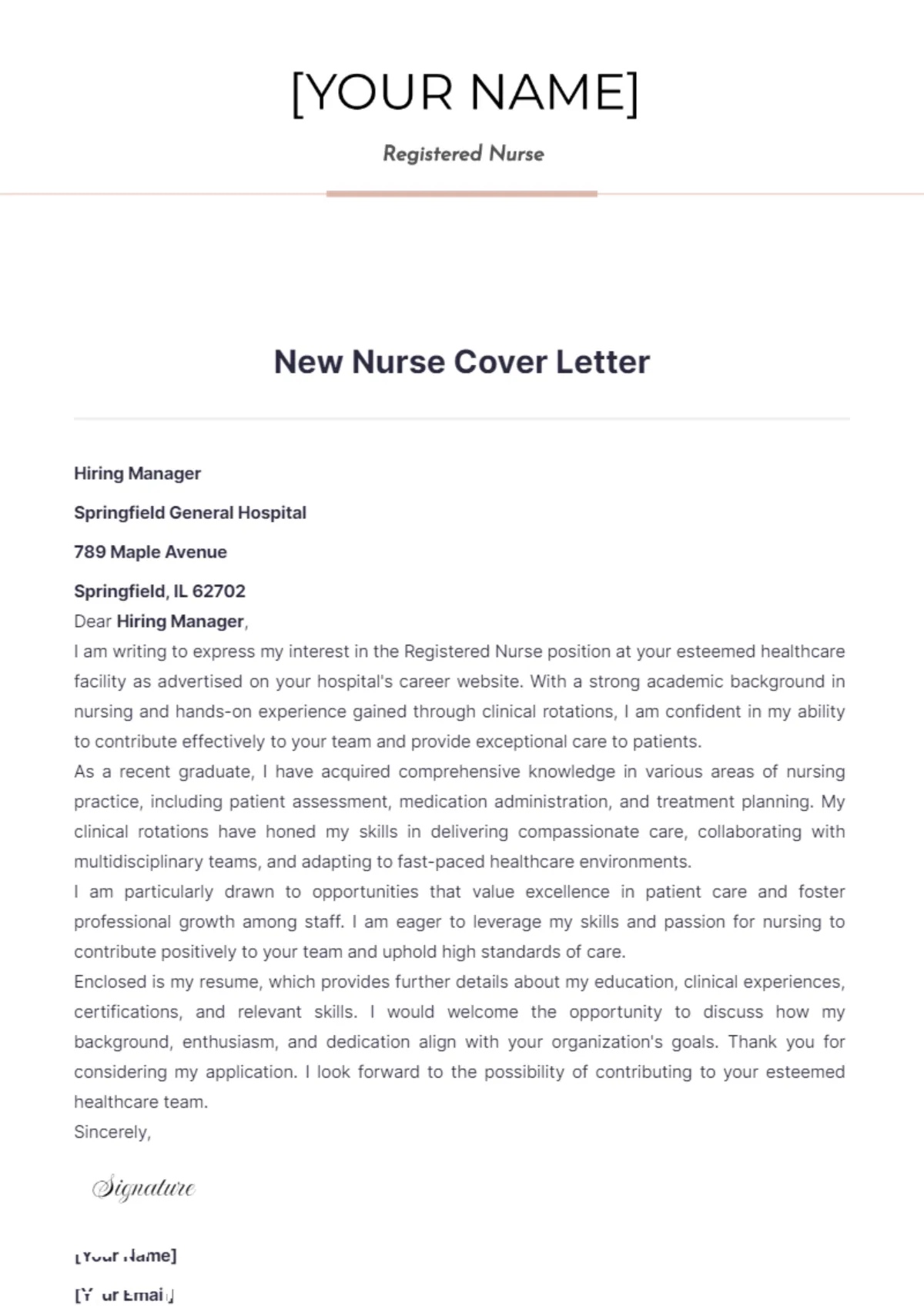What is a New Nurse Cover Letter?
A new nurse cover letter is a crucial document that accompanies your resume when applying for nursing positions. It serves as a personal introduction, allowing you to showcase your skills, experience, and passion for nursing. Unlike a resume, which provides a factual overview of your qualifications, a cover letter gives you the opportunity to express your personality, explain your career goals, and demonstrate why you are the perfect fit for the specific role and healthcare facility. It’s your first chance to make a strong impression and persuade the hiring manager to consider your application further.
Why is a Cover Letter Important for New Nurses?
For new nurses, a cover letter is particularly important because it helps bridge the gap between limited professional experience and the requirements of the job. While your resume may highlight your education and any clinical rotations, the cover letter allows you to expand on these experiences and articulate your unique value proposition. It provides a platform to demonstrate your understanding of the nursing profession, your commitment to patient care, and your eagerness to learn and grow. A well-crafted cover letter can set you apart from other applicants, especially in a competitive job market, by highlighting your enthusiasm and potential.
Key Components of a New Nurse Cover Letter
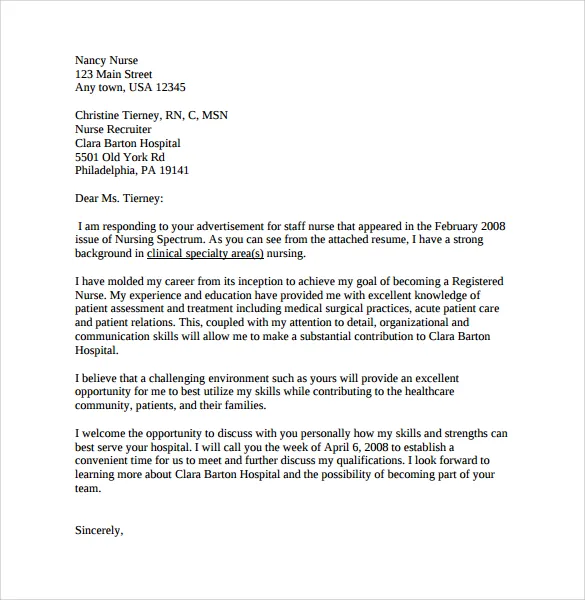
A strong new nurse cover letter is comprised of several key components that work together to present you as a qualified and enthusiastic candidate. These elements ensure clarity, professionalism, and a compelling narrative. Structuring your letter correctly is vital for readability and making a positive impression on the hiring manager. Each part should be carefully considered and tailored to the specific job and facility you are applying for.
Contact Information
This section includes your contact details, as well as the hiring manager’s information. This ensures that the recipient knows where to reach you and shows that you have taken the time to personalize the letter, which makes a good first impression. Accuracy is paramount, as any errors here could lead to missed opportunities. The aim is to provide all necessary information efficiently and correctly.
Your Name and Address
At the top of your cover letter, include your full name, address, phone number, and professional email address. Make sure your email address is professional and appropriate. Using a clear and easily readable format is essential for presenting your information in an organized manner. This ensures that the hiring manager can easily identify you and your contact details. Using a modern, easy-to-read font is also a good idea.
Date
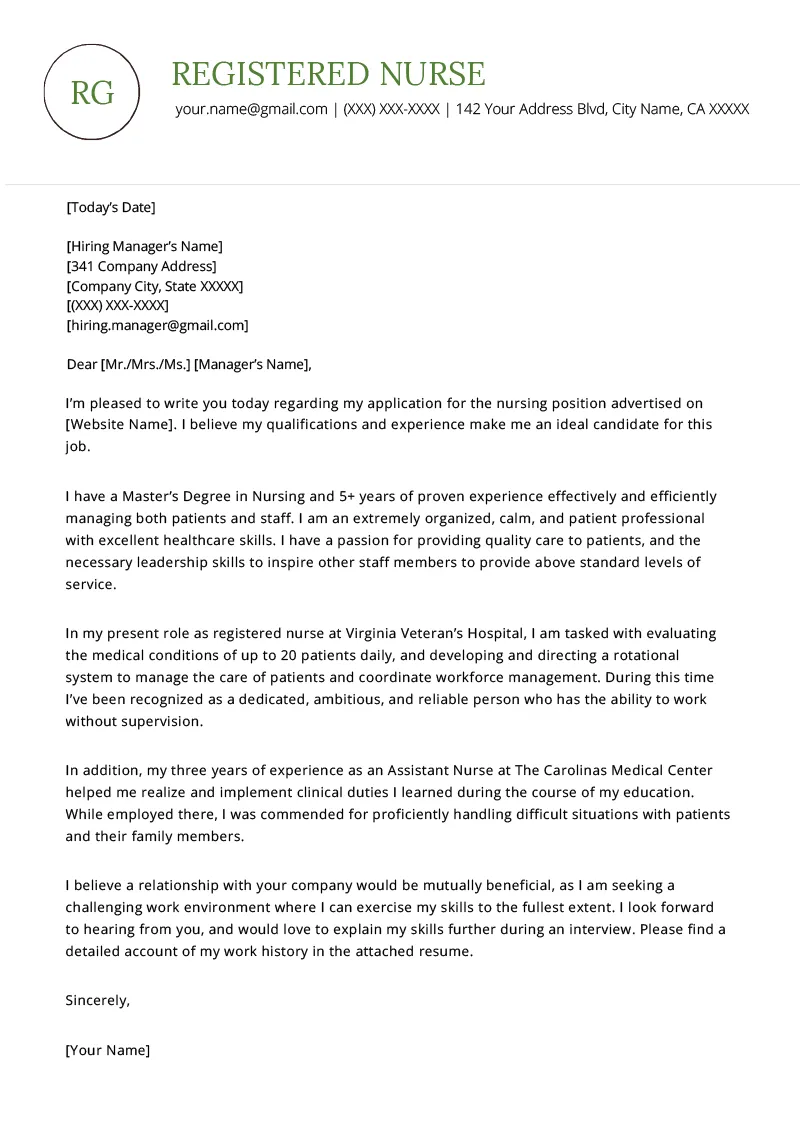
Include the date on which you are sending your cover letter. The date is typically placed below your contact information, providing a reference point for when the letter was written. This detail helps with tracking and organization, allowing the hiring manager to understand the timeliness of your application.
Hiring Manager’s Information
If possible, address your cover letter to a specific person, such as the hiring manager or the nurse recruiter. Research the name and title of the person responsible for reviewing applications. If you are unsure, you can often find this information on the job posting or the healthcare facility’s website. Addressing the letter to a specific individual makes it more personal and shows that you have taken the initiative to personalize the application.
Salutation
Use a formal salutation, such as “Dear Mr./Ms./Mx. [Last Name],” if you know the hiring manager’s name. If you don’t know the hiring manager’s name, a professional alternative is “Dear Hiring Manager.” Avoid generic salutations like “To Whom It May Concern,” which can make your letter seem impersonal. The salutation sets the tone for your entire letter, so it should be professional and courteous.
Writing the Body of Your New Nurse Cover Letter
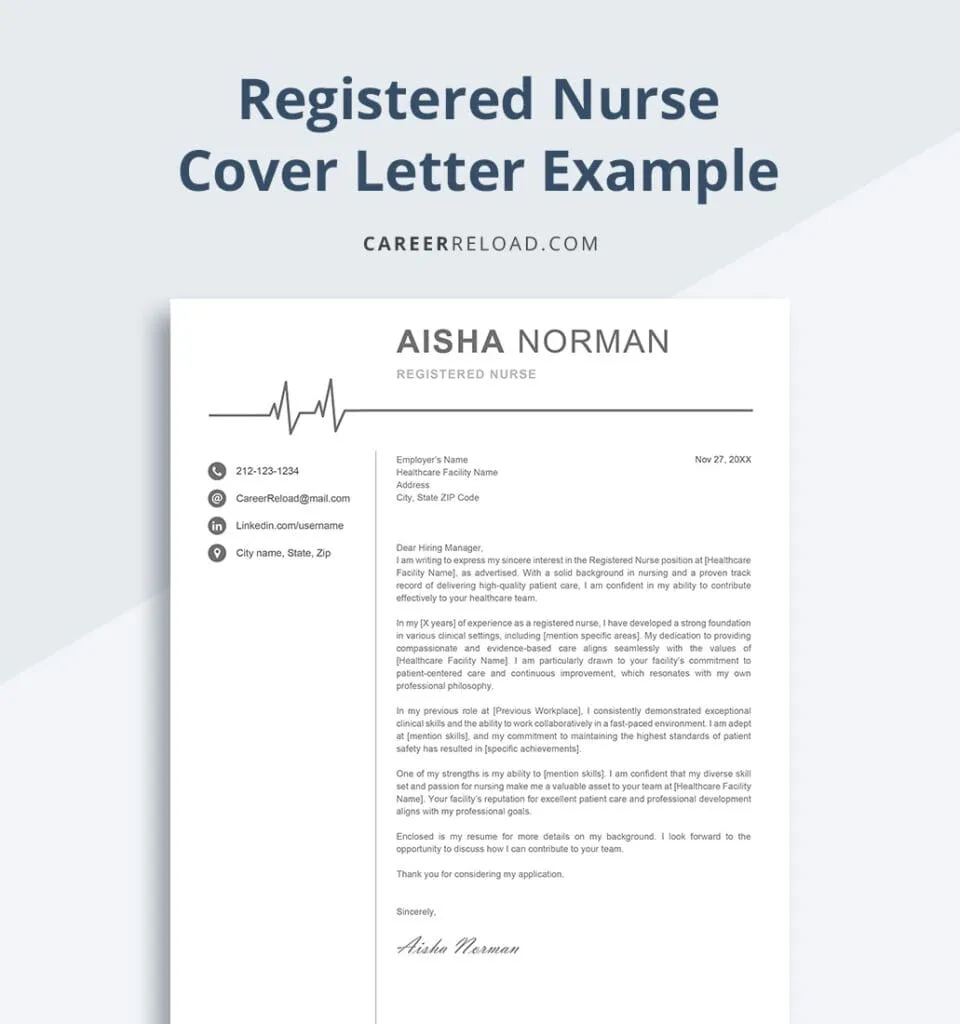
The body of your new nurse cover letter is where you make your case for why you’re the best candidate. It should be well-structured, engaging, and tailored to the specific job and healthcare facility. The body typically includes an introductory paragraph, several paragraphs that highlight your skills and experience, and a concluding paragraph. Each paragraph has a specific purpose in persuading the reader to consider your application.
First Paragraph Introducing Yourself
Start your cover letter with a strong opening statement that immediately grabs the hiring manager’s attention. State the position you are applying for and where you saw the job posting. Briefly mention your qualifications and enthusiasm for the role. The goal of this paragraph is to introduce yourself and indicate why you’re writing. Keep it concise and enthusiastic to encourage the reader to continue reading.
Highlighting Your Skills and Experience
In the body of your letter, focus on the skills and experiences that are most relevant to the nursing position. Discuss clinical rotations, coursework, and any volunteer or extracurricular activities that demonstrate your abilities. Show how your skills align with the requirements of the job description. This is the opportunity to demonstrate your practical knowledge and abilities, proving that you’re ready to take on the challenges of the role. Use the STAR method (Situation, Task, Action, Result) to provide specific examples.
Emphasizing Your Education and Certifications
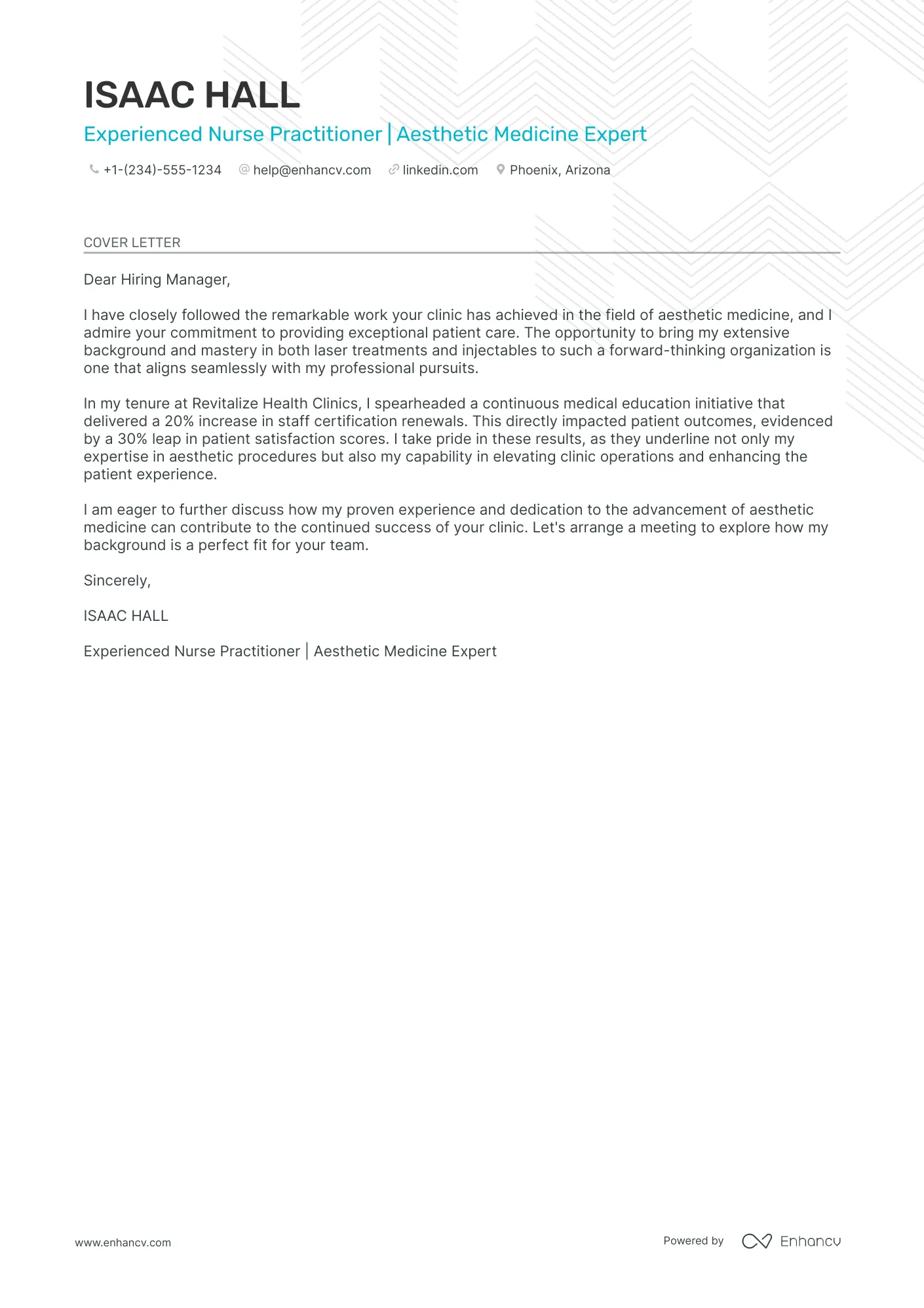
Highlight your nursing education, including the name of your nursing school and your degree. Mention any relevant certifications, such as BLS, ACLS, or specialized certifications. Be sure to mention your GPA if it is particularly impressive and align your educational background with the job’s needs. Make sure to keep all information relevant and updated.
Emphasize your passion for nursing by sharing your motivations, values, and goals. Discuss why you chose nursing as a profession and what aspects of patient care excite you most. Showing genuine enthusiasm can make a lasting impression. Illustrate your commitment to providing quality care and developing meaningful relationships with patients and their families. Convey your desire to contribute to the healthcare facility’s mission and values.
Second Paragraph: Why This Role?
In this paragraph, explain why you are interested in the specific role and healthcare facility. Tailor your letter to the job description, highlighting how your skills and experiences align with the role’s requirements. Research the healthcare facility and mention specific aspects that appeal to you. Clearly articulate why this particular position is a good fit for your career aspirations. This helps demonstrate to the hiring manager that you have taken the time to research and understand the opportunity.
Tailoring Your Letter to the Job Description
Carefully review the job description and identify the key requirements and qualifications. Use keywords from the job description in your cover letter to show that you possess the necessary skills and experience. Provide examples of how you have demonstrated those skills in the past. Customizing your letter ensures that you address the employer’s needs and show that you are a strong match for the position.
Researching the Healthcare Facility

Before writing your cover letter, research the healthcare facility. Understand its mission, values, and recent achievements. Mention specific aspects of the facility that appeal to you, such as its reputation for patient care or its commitment to innovation. This shows that you have done your homework and are genuinely interested in joining the organization. Knowing the organization’s values and goals will help you present yourself as a well-matched candidate.
Third Paragraph: Call to Action
In the final paragraph, express your enthusiasm for the opportunity and reiterate your interest in the position. Thank the hiring manager for their time and consideration. Include a call to action, such as stating your availability for an interview. Be clear, concise, and confident in your message. A strong closing reinforces your interest and leaves a positive impression.
Expressing Your Enthusiasm
Reiterate your excitement for the position and the opportunity to contribute to the healthcare facility. Show that you are eager to learn and grow in the role. Highlight your passion for patient care and your desire to make a difference. Enthusiasm is contagious, and it will make you stand out from other candidates.
Thanking the Reader
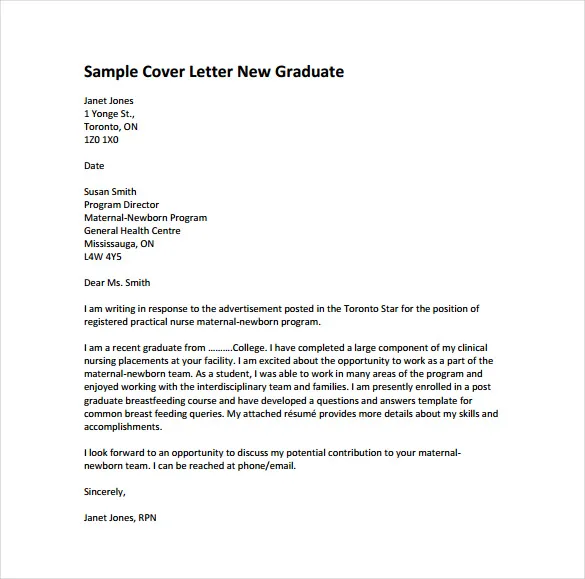
Thank the hiring manager for taking the time to review your application. Express your appreciation for their consideration. A simple thank you is a sign of respect and professionalism. This gesture concludes your letter on a positive note and demonstrates your gratitude.
Closing Your New Nurse Cover Letter
The closing of your cover letter should be professional and courteous. The closing should summarize your interest and express your gratitude. Formatting your closing correctly makes a final positive impression on the hiring manager. Always double-check that you’ve adhered to the proper formatting to ensure a polished finish.
Formal Closing
Use a formal closing, such as “Sincerely,” “Best regards,” or “Thank you.” These closings are appropriate and professional for a cover letter. Select the closing that best aligns with your tone and style. Make sure the closing is placed directly before your typed name, creating a clean and organized finish.
Your Typed Name
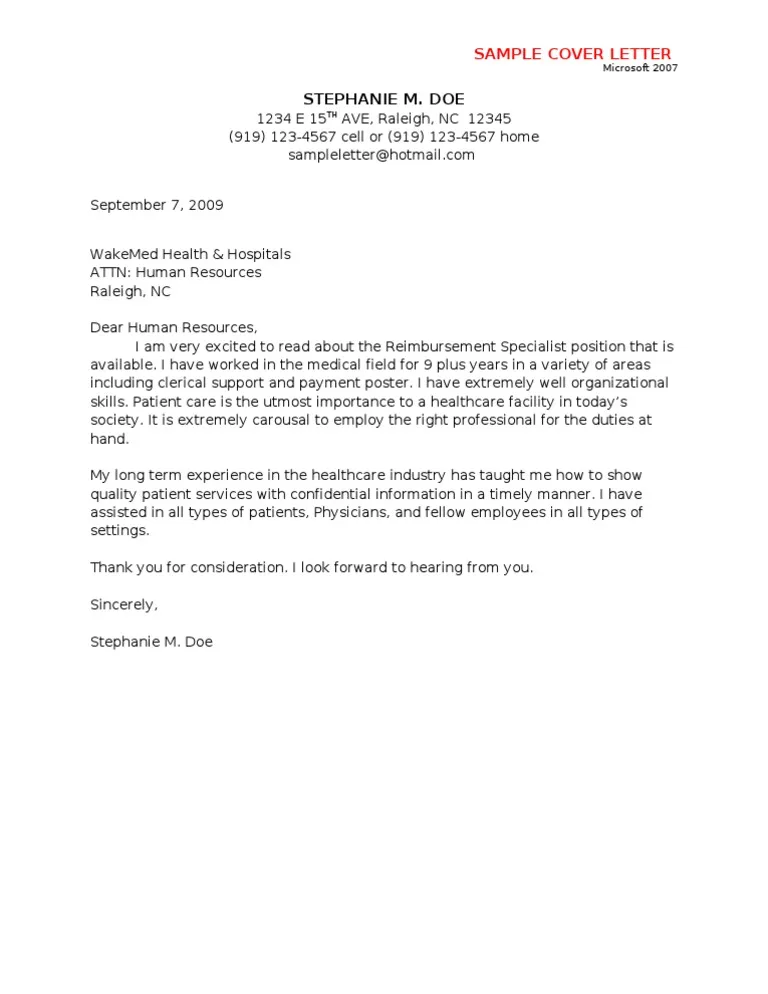
Type your full name below the closing. This provides a clear signature and makes your letter easily identifiable. Ensure that your typed name is clearly displayed to facilitate the hiring manager’s review process. This final touch ensures that your cover letter is complete and professional.
Proofreading and Formatting
Proofreading and formatting are critical for a professional cover letter. Errors and inconsistencies can make a negative impression on the hiring manager. Paying attention to these details ensures that your letter is polished and easy to read. It also demonstrates your attention to detail.
Formatting Guidelines
Use a professional font, such as Times New Roman, Arial, or Calibri, with a font size between 10 and 12 points. Ensure that your cover letter is well-formatted with clear headings, consistent spacing, and proper paragraphing. Maintain consistent margins throughout the document. A well-formatted cover letter is easier to read and conveys professionalism. Also, make sure to keep your letter to one page, if possible.
Proofreading for Errors
Carefully proofread your cover letter for any grammatical errors, spelling mistakes, or typos. Ask a friend, family member, or career counselor to review your letter as a second pair of eyes can catch errors that you might miss. Ensuring that your letter is free of errors demonstrates your attention to detail and professionalism. Proofreading is an essential step to ensure that your message is clear and error-free.
Example New Nurse Cover Letter
Here is an example of a new nurse cover letter. This is just a sample and should be tailored to your specific situation and the job description. The example highlights the key components and provides a clear structure. Use the example as a template to create your own customized cover letter. Remember to substitute the example details with your information and experiences.
Common Mistakes to Avoid
Avoid common mistakes that can undermine your cover letter. These mistakes can decrease your chances of landing an interview. Being aware of these pitfalls and avoiding them can significantly improve the effectiveness of your application. Reviewing these errors can help you prevent issues that may occur.
Generic Cover Letters
Avoid sending generic cover letters that are not tailored to the specific job or healthcare facility. Generic letters lack personalization and demonstrate a lack of interest. Each cover letter should be customized to the particular position and the facility’s needs. Demonstrating a genuine interest in the role and organization will stand out more.
Typos and Grammatical Errors
Always proofread your cover letter for typos and grammatical errors. Errors can create a negative impression and suggest a lack of attention to detail. Check all spelling and grammar before submitting your application. Proofreading ensures that your letter is polished and professional, helping you make a good first impression.
Overly Long Letters
Keep your cover letter concise and to the point. Avoid writing overly long letters that can lose the reader’s interest. Aim to keep your cover letter to one page. Highlighting your most important qualifications and experiences in a clear and concise manner is essential. Brevity is key to making a strong impact.
Tips for Standing Out
Use these strategies to make your cover letter stand out. These techniques help you showcase your unique qualifications and personality. Implementing these strategies will make you more competitive and improve your chances of getting an interview. They are designed to highlight your strong qualities.
Use Action Verbs
Use strong action verbs to describe your skills and experiences. Action verbs make your letter more dynamic and engaging. Verbs help to convey your capabilities and achievements effectively. Use verbs that are specific and descriptive, helping the reader visualize your accomplishments.
Quantify Your Achievements
Wherever possible, quantify your achievements with specific numbers or data. Use numbers to measure your successes, demonstrating the impact of your actions. For example, you can mention the number of patients you cared for or the percentage of improvement in patient outcomes. This shows the value you can bring to the role. Quantifiable accomplishments provide concrete evidence of your capabilities.
Highlight Relevant Skills
Focus on the skills and experiences that are most relevant to the job description. Tailor your cover letter to meet the requirements of the position. Show how your skills align with the needs of the healthcare facility. This will help you to position yourself as a well-suited candidate.
Submitting Your New Nurse Cover Letter
Submit your cover letter and resume in the format specified by the employer. Make sure all your documents are in a professional format (PDF). Carefully review the job posting for submission instructions. Following these steps will help to guarantee that your application is viewed in its intended format.
Following Up After Submission
If you haven’t heard back within a reasonable timeframe, consider following up with the hiring manager or recruiter. Send a brief email expressing your continued interest in the position. Express your interest in the role, but be mindful and respectful of the hiring process. Following up can demonstrate your enthusiasm and commitment, potentially increasing your chances of being considered.
